Research on the Optimization of a Diesel Engine Intercooler Structure Based on Numerical Simulation
Abstract
:1. Introduction
2. Numerical Approaches
2.1. Governing Equation
2.1.1. Continuity Equation
2.1.2. Equation for Conservation of Momentum
2.1.3. Equation for Conservation of Energy
2.2. The Turbulence Models
2.3. Calculation of Heat Transfer
3. Construction of the Experimental Platform
4. CFD Model Details
4.1. Physical Model
4.2. Three-Dimensional Simulation Model and Grid Settings
4.3. Boundary Conditions
- Inlet boundary condition: the charge air inlet in the intercooler is set to the velocity boundary condition, which means that air velocity is specified.
- Outlet boundary condition: the charge air outlet in the intercooler is set to the pressure outlet boundary condition, which means that pressure and backflow are defined.
- Handling of cooling fins: to reduce the amount of computation, the cooling fins were simulated using a porous media model. The porosity of the porous region is set to be 0.9, and the viscous resistance coefficient and inertial resistance coefficient of the porous media model are calculated by the following equation:where and are the viscous resistance coefficients and inertial resistance coefficients of the porous media model, respectively [36].
4.4. Reliability Verification of Simulation Models
5. Results and Discussion
5.1. Effect of Charged Air Mass Flow on the Flow Field in the Intercooler
5.2. Effect of Tube Bundle Transverse Spacing on the Flow Field in the Intercooler
5.3. Summary and Analysis of Results
5.4. Comparison of Optimization Results
6. Gray Correlation Analysis
- (1)
- Determine the calculation sequence.
- (2)
- Normalization.
- (3)
- Calculation of grey relevance.
7. Conclusions
- (1)
- Comparing the pressure and velocity flow fields of the intercooler corresponding to the transverse spacing of different cooling water pipes, it can be seen that with the increase in the spacing of the water pipes, the pressure value of the intercooler at the inlet decreases and the velocity value increases, because expanding the transverse spacing of the cooling water pipes will increase the change rate of the flow area at the inlet of the intercooler, resulting in the aggravation of the airflow disturbance of the charged air and increasing the pressure loss, and at the same time, the speed of the charged air increases due to the squeezing effect caused by the change in the area of the flow area. The increase in charged air velocity further improves the heat dissipation performance of the intercooler.
- (2)
- According to the heat transfer coefficient of the heat sink band calculated by simulation under the spacing of each cooling water pipe and the charged air mass flow, it can be seen that within the range of satisfying the regular operation of the supercharged diesel engine, the cooling pipe spacing and air mass flow are positively correlated with the heat transfer coefficient of the intercooler heat dissipation belt. That is, increasing the spacing of the cooling pipes of the intercooler and the charged air mass flow rate can improve the heat transfer capacity of the intercooler, and the heat transfer coefficient can be increased by up to 57%. However, the spacing of the cooling pipes is too high, increasing the pressure loss of the charged air. Hence, the optimal solution of the tube bundle transverse spacing is 17 mm, while ensuring the pressure drop of the charged air, and the heat dissipation of the intercooler is increased by 6.04%.
- (3)
- The grey correlation degrees of the mass flow rate of the charged air, the tube bundle transverse spacing, and the pressure drop on the air side of the intercooler relative to the heat transfer coefficient of the heat sink band of the intercooler were 0.8464, 0.8497, and 0.8039, respectively. The heat dissipation performance of the intercooler is most affected by the tube bundle transverse spacing, followed by the mass flow of the charged air, and the pressure drop on the air side of the intercooler is the least affected. The grey correlation values of the three parameters are all greater than 0.8, indicating that the three parameters have a large degree of correlation with the heat transfer capacity of the intercooler. The heat dissipation performance of the intercooler can be improved by optimizing the above three parameter values.
- (4)
- The heat dissipation rate of the intercooler obtained based on the porous media model was compared with the experimental value measured by the steady flow test bench; the data consistency was good, the error was within 10%, and the heat dissipation performance of the intercooler can be studied by using the model. The design of the intercooler structure through the simulation results can effectively reduce the R&D investment in design and reduce the R&D cost of the enterprise.
Author Contributions
Funding
Data Availability Statement
Acknowledgments
Conflicts of Interest
Nomenclature
| The volume of the controlling element (m3) | |
| The area of the control element (m2) | |
| The density of the fluid in the inflow control element (kg/m3) | |
| The volume force per unit mass of the control element (N) | |
| The viscous force on the surface of the control element (N) | |
| The pressure on the surface of the control element (N/m2) | |
| The thermal conductivity of the fluid | |
| The internal heat source of the fluid | |
| The work carried out by the surface force on the fluid element | |
| The production term of turbulent kinetic energy due to the mean velocity gradient | |
| Due to the buoyancy-induced turbulent kinetic energy production term | |
| The directional component of the acceleration of gravity | |
| The turbulent Prandtl number | |
| The pulsating expansion part of the compressible turbulence | |
| The turbulent Mach number | |
| The Prandtl numbers corresponding to turbulent kinetic energy | |
| The Prandtl numbers corresponding to the dissipation rate | |
| The heat transfer rate per unit of time | |
| The area of the heat dissipation area | |
| The logarithmic value of the average temperature difference | |
| The average heat transfer coefficient of the intercooler | |
| The cold fluid temperatures at the inlet of the intercooler | |
| The hot fluid temperatures at the inlet of the intercooler | |
| The cold fluid temperatures at the outlet of the intercooler | |
| The hot fluid temperatures at the outlet of the intercooler |
References
- Tang, X.; Shi, Q.; Li, Z.; Xu, S.; Li, M. Research on the influence of the guide vane on the performances of intercooler based on the end-to-end prediction model. Int. J. Heat Mass Transf. 2022, 192, 122903. [Google Scholar] [CrossRef]
- Liu, S.; Tu, A.; Li, Y.; Zhu, D. Optimization Design and Comparative Analysis of Enhanced Heat Transfer and Anti-Vibration Performance of Twisted-Elliptic-Tube Heat Exchanger: A Case Study. Energies 2023, 16, 6336. [Google Scholar] [CrossRef]
- Engkuah, S.; Nasution, H.; Abdul Aziz, A. Performance Characteristic Study on Air to Water Intercooler. Appl. Mech. Mater. 2016, 819, 42–45. [Google Scholar] [CrossRef]
- Muqeem, M. Turbocharging with Air Conditioner Assisted Intercooler. IOSR J. Mech. Civ. Eng. 2012, 2, 38–44. [Google Scholar] [CrossRef]
- Yu, Q.; Chai, H.L. The Effect of Compressible Flow on Heat Transfer Performance of Heat Exchanger by Computational Fluid Dynamics (CFD) Simulation. Entropy 2019, 21, 829. [Google Scholar] [CrossRef]
- Yaïci, W.; Ghorab, M.; Entchev, E. 3D CFD analysis of the effect of inlet air flow maldistribution on the fluid flow and heat transfer performances of plate-fin-and-tube laminar heat exchangers. Int. J. Heat Mass Transf. 2014, 74, 490–500. [Google Scholar] [CrossRef]
- Yu, C.; Zhang, W.; Xue, X.; Lou, J.; Lao, G. Analysis of Water-Cooled Intercooler Thermal Characteristics. Energies 2021, 14, 8332. [Google Scholar] [CrossRef]
- Zhang, Q.; Qin, S.; Ma, R. Simulation and experimental investigation of the wavy fin-and-tube intercooler. Case Stud. Therm. Eng. 2016, 8, 32–40. [Google Scholar] [CrossRef]
- Djemel, H.; Ben Salem, M.; Baccar, M.; Mseddi, M. Three-dimensional numerical study of the intercooler equipped with vortex generators. Heat Transf. Res. 2017, 48, 715–740. [Google Scholar] [CrossRef]
- Dong, J.Q.; Su, L. Experimental study on thermal-hydraulic performance of a wavy fin-and-flat tube aluminum heat exchanger. Appl. Therm. Eng. 2013, 51, 32–39. [Google Scholar] [CrossRef]
- Seo, J.; Cho, C.; Lee, S.; Choi, Y. Thermal Characteristics of a Primary Surface Heat Exchanger with Corrugated Channels. Entropy 2015, 18, 15. [Google Scholar] [CrossRef]
- Wen, J.; Li, Y.; Zhou, A. PIV experimental investigation of entrance configuration on flow maldistribution in plate-fin heat exchanger. Cryogenics 2006, 46, 37–48. [Google Scholar] [CrossRef]
- Habib, M.; Mansour, R.; Said, S. Evaluation of flow maldistribution in air-cooled heat exchangers. Comput. Fluids 2009, 38, 677–690. [Google Scholar] [CrossRef]
- Kays, W.; London, A. Compact Heat Exchangers; McGraw-Hill: New York, NY, USA, 1984. [Google Scholar]
- Liu, Y.; Yu, C.; Qin, S.; Wang, X.; Lou, J. Effect of transverse flow in porous medium on heat exchanger simulation optimization. Trans. Can. Soc. Mech. Eng. 2020, 44, 419–426. [Google Scholar] [CrossRef]
- Liu, Z.; Sun, M.; Huang, Y.; Li, K.; Wang, C. Investigation of heat transfer characteristics of high-altitude intercooler for piston aero-engine based on multi-scale coupling method. Int. J. Heat Mass Transf. 2020, 156, 119898. [Google Scholar] [CrossRef]
- Huang, Y.; Liu, Z.; Lu, G.; Yu, X. Multi-scale thermal analysis approach for the typical heat exchanger in automotive cooling systems. Int. Commun. Heat Mass Transf. 2014, 59, 75–87. [Google Scholar] [CrossRef]
- Sadeghianjahromi, A.; Nematih, K.S. Developed correlations for heat transfer and flow friction characteristics of louvered finned tube heat exchangers. Int. J. Therm. Sci. 2018, 129, 135–144. [Google Scholar] [CrossRef]
- Huminic, G.; Huminic, A. A numerical approach on hybrid nanofluid behavior in laminar duct flow with various cross sections. J. Therm. Anal. Calorim. 2020, 140, 2097–2110. [Google Scholar] [CrossRef]
- Zhao, X.; Grönstedt, T. Conceptual design of a two-pass cross-flow aeroengine intercooler. Proc. Inst. Mech. Eng. Part G J. Aerosp. Eng. 2014, 229, 2006–2023. [Google Scholar] [CrossRef]
- Zhao, X.; Tokarev, M.; Adi Hartono, E.; Chernoray, V.; Grönstedt, T. Experimental Validation of the Aerodynamic Characteristics of an Aero-engine Intercooler. J. Eng. Gas Turbines Power 2017, 139, 1201–1203. [Google Scholar] [CrossRef]
- Sheng, Y.; Liu, Z. Research on the integrated intercooler intake system of turbocharged diesel engine. Int. J. Automot. Technol. 2020, 21, 339–349. [Google Scholar]
- Masri, A.A.; Blum, M.L. A 3D Model for predicting the Temperature Distribution in a Full Scale APU SOFC Short Stack under Transient operating conditions. Appl. Energy 2014, 135, 539–547. [Google Scholar] [CrossRef]
- Connect, P.; Learn, S. Heat and Mass Transfer: Fundamentals and Applications. Bus. Econ. 2014, 15, 774. [Google Scholar]
- Jones, W.; Launder, B. The prediction of laminarization with a two-equation model of turbulence. Int. J. Heat Mass Transf. 1972, 15, 301–314. [Google Scholar] [CrossRef]
- Wu, J.; Tao, W. Effect of longitudinal vortex generator on heat transfer in rectangular channels. Appl. Therm. Eng. 2012, 37, 67–72. [Google Scholar] [CrossRef]
- Fluent Inc. (FLUENT, v6).3 User Manual; Fluent Inc.: New Lebanon, NH, USA, 2008. [Google Scholar]
- Yang, L.; Sicheng, Q. The optimization design of off-highway machinery radiator based on genetic algorithm and e-NTU. Acta Tech. (Former. Acta Tech. CSAV) 2017, 62, 465–476. [Google Scholar]
- Mesbah, M.; Georgievich Gribin, V.; Souri, K. Evaluation of different turbulence models in simulating the subsonic flow through a turbine blade cascade. IOP Conf. Ser. Mater. Sci. Eng. 2021, 1092, 012064. [Google Scholar] [CrossRef]
- Iyer, A.; Abe, Y.; Vermeire, B.; Bechlars, P.; Baier, R.; Jameson, A.; Witherden, F.; Vincent, P. High-Order Accurate Direct Numerical Simulation of Flow over a MTU-T161 Low Pressure Turbine Blade. Comput. Fluids 2021, 15, 104989. [Google Scholar] [CrossRef]
- Nakhchi, M.; Rahmati, M. Direct numerical simulations of flutter instabilities over a vibrating turbine blade cascade. J. Fluids Struct. 2021, 104, 103324. [Google Scholar] [CrossRef]
- Gadde, S.N.; Liu, L.; Stevens, R.J.A.M. Effect of low-level jet on turbine aerodynamic blade loading using large-eddy simulations. J. Phys. Conf. Ser. 2021, 1934, 012001. [Google Scholar] [CrossRef]
- Yu, C.; Xue, X.; Shi, K.; Shao, M.; Liu, Y. Comparative Study on CFD Turbulence Models for the Flow Field in Air Cooled Radiator. Processes 2020, 8, 1687. [Google Scholar] [CrossRef]
- Taira, K.; Brunton, S.; Dawson, S.; Rowley, C.; Colonius, T.; McKeon, B.; Ukeiley, L. Modal analysis of fluid flows: An overview. AIAA J. 2017, 55, 4013–4041. [Google Scholar] [CrossRef]
- Launder, J.; Dong, B. Spalding, Mathematical Models of Turbulence; Academic Press: London, UK, 1972. [Google Scholar]
- Fakheri, A. The Shell and Tube Heat Exchanger Efficiency and Its Relation to Effectiveness. In Proceedings of the ASME 2003 International Mechanical Engineering Congress and Exposition, Washington, DC, USA, 15–21 November 2003. ASME Paper IMECE2003-41633. [Google Scholar]
- Fluent Inc. User’s Guide, 7.19.6. FLUENT 6.2 Documentation; Fluent Inc.: New York, NY, USA, 2005. [Google Scholar]
- Dong, J.; Chen, J.; Chen, Z.; Zhou, Y.; Zhang, W. Heat transfer and pressure drop correlations for the wavy fin and flat tube heat exchangers. Appl. Therm. Eng. 2007, 27, 2066–2073. [Google Scholar]
- Zhang, X.; Jin, F.; Liu, P. A grey relational projection method for multi-attribute decision making based on intuitionistic trapezoidal fuzzy number. Appl. Math. Model. 2013, 37, 3467–3477. [Google Scholar] [CrossRef]
- Zhang, Z.; Li, J.; Tian, J.; Xie, G.; Tan, D.; Qin, B.; Huang, Y.; Cui, S. Effects of Different Diesel-Ethanol Dual Fuel Ratio on Performance and Emission Characteristics of Diesel Engine. Processes 2021, 9, 1135. [Google Scholar] [CrossRef]
- Li, M.; Li, Y.; Jiang, F.; Hu, J. An Optimization of a Turbocharger Blade Based on Fluid–Structure Interaction. Processes 2022, 10, 1569. [Google Scholar] [CrossRef]
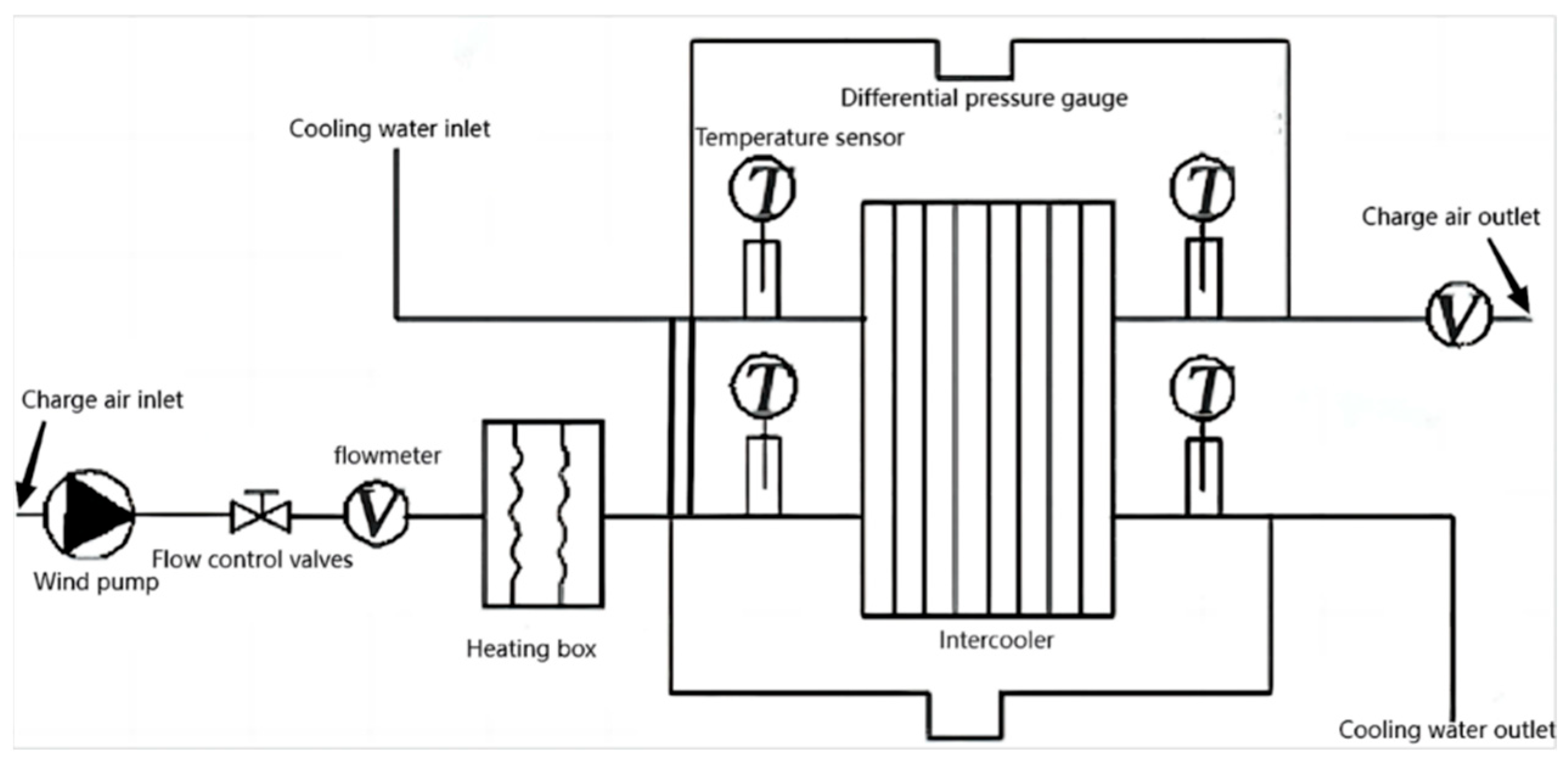
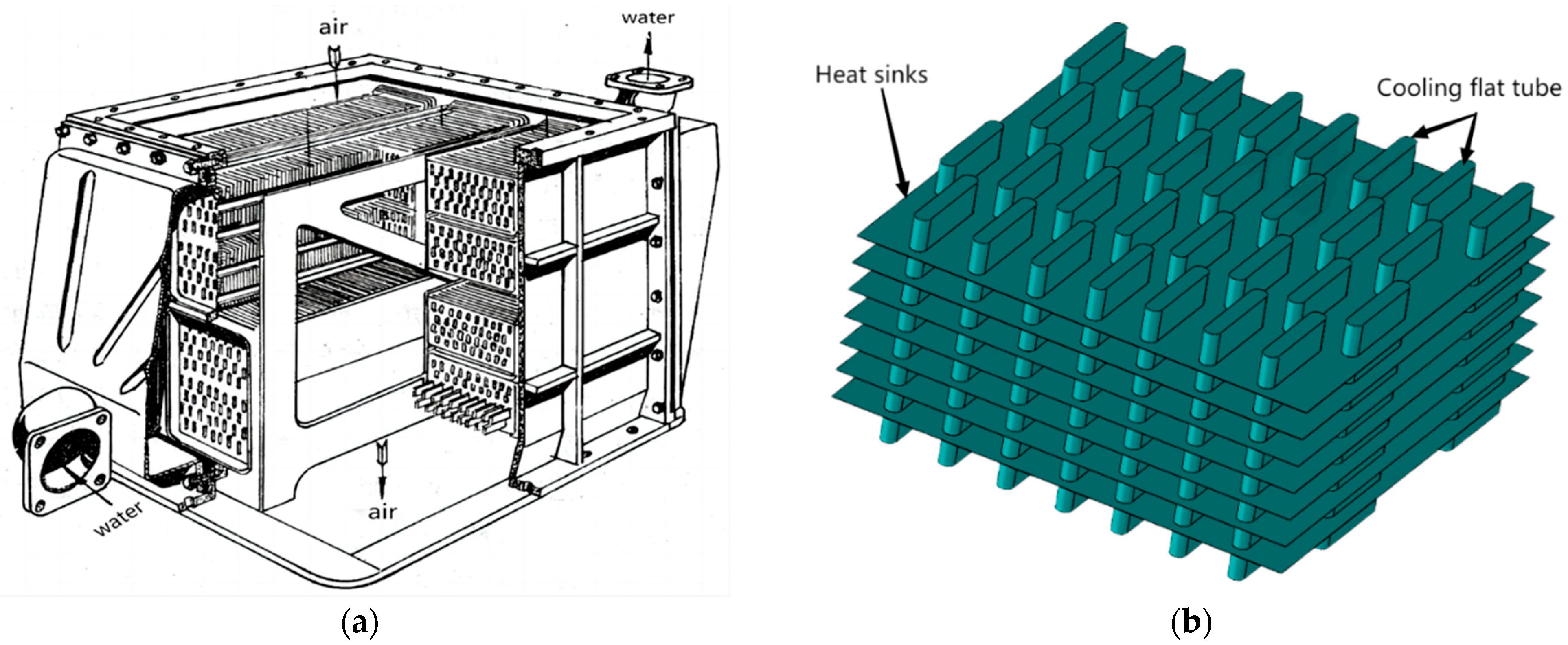

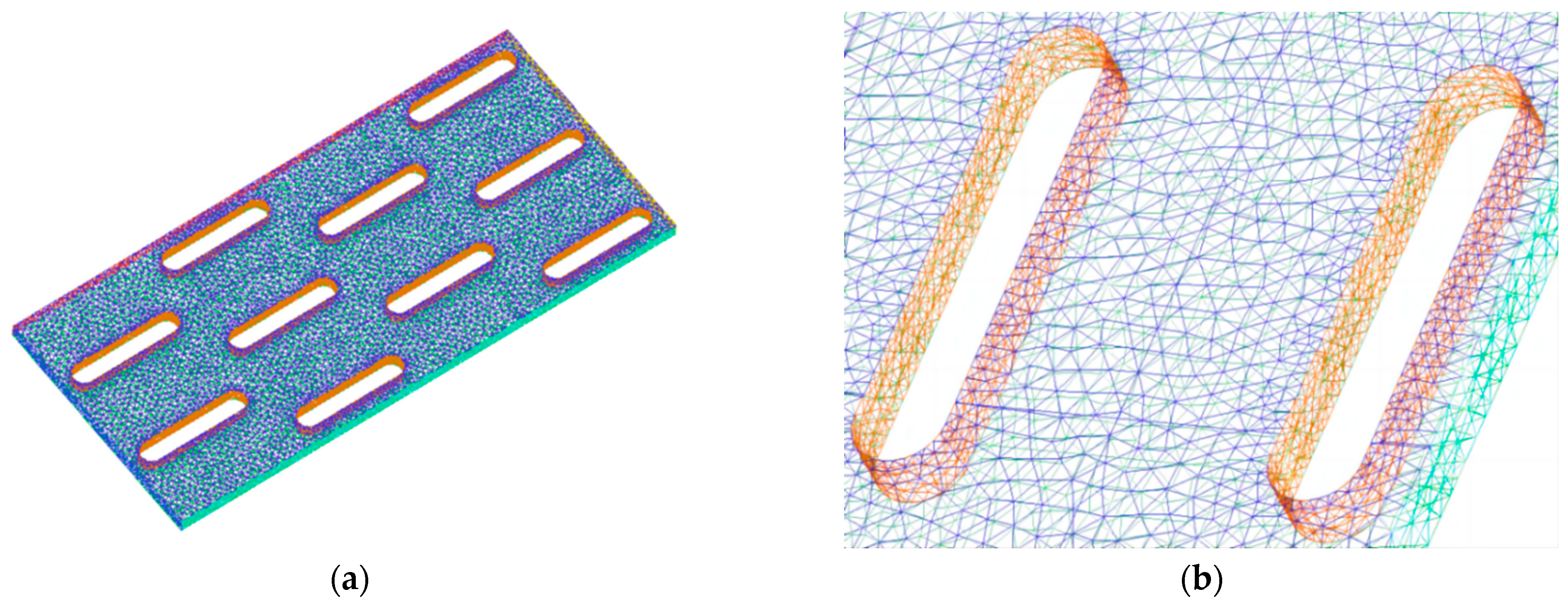
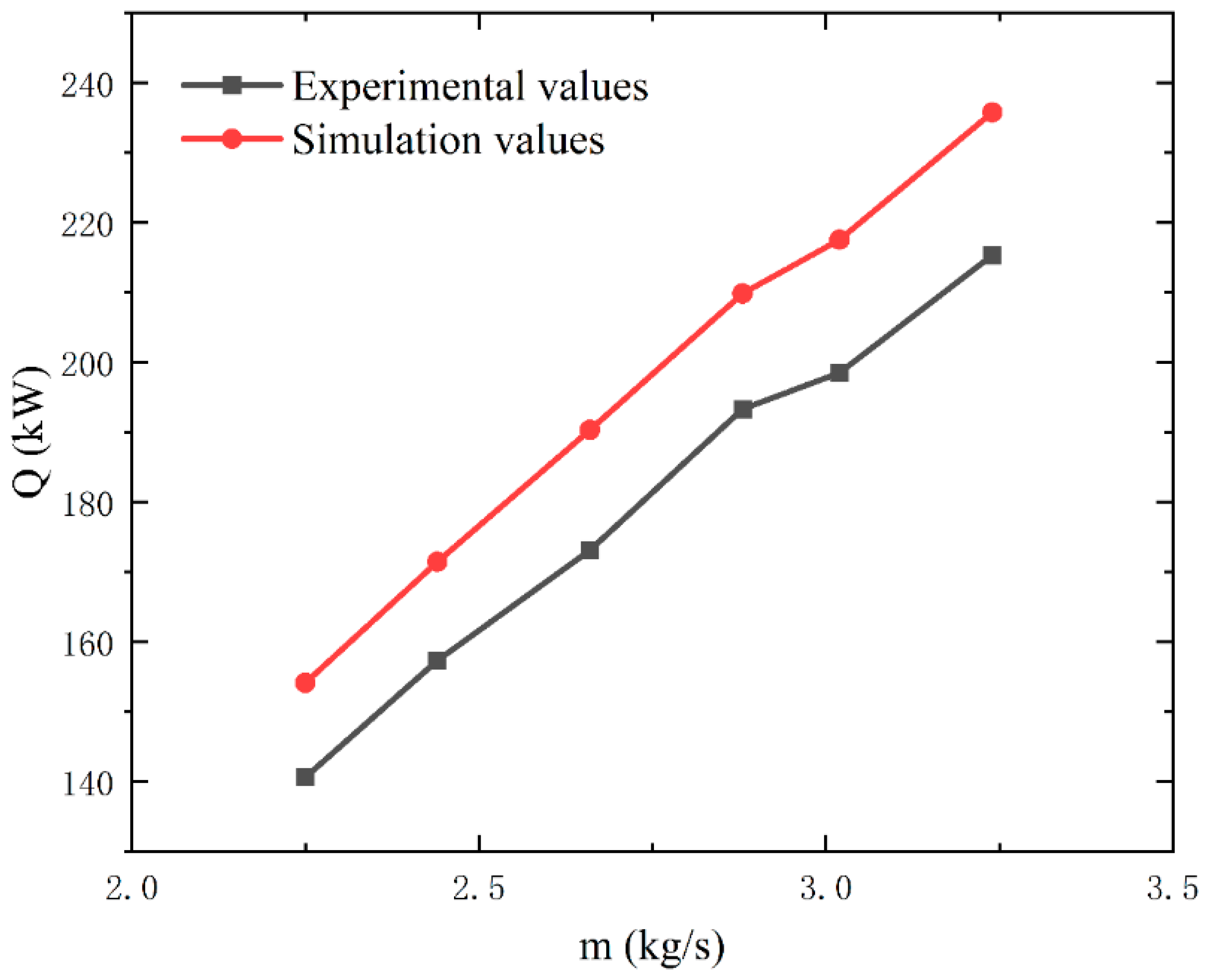




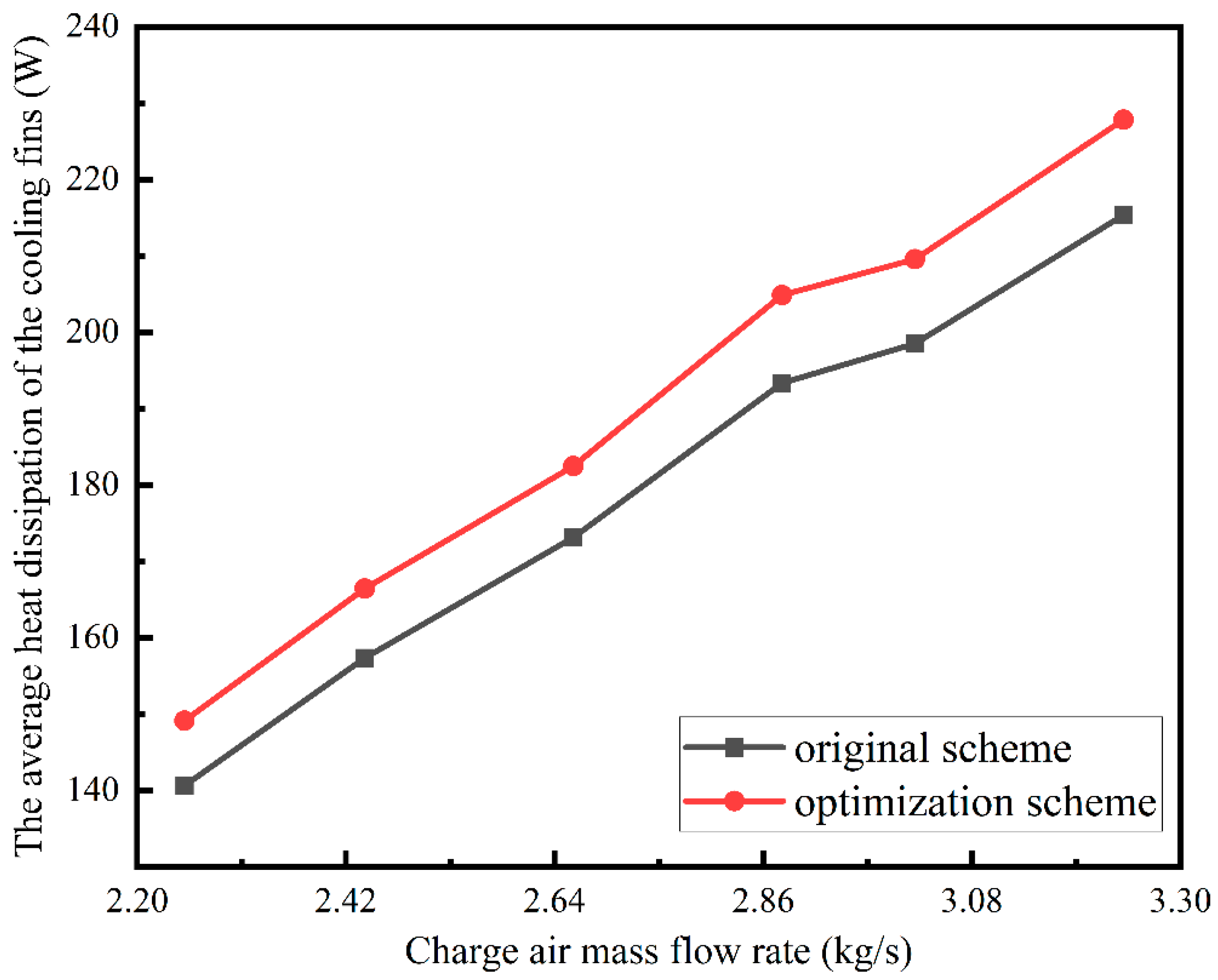
| Items | Unit | 1 | 2 | 3 | 4 | 5 | 6 |
|---|---|---|---|---|---|---|---|
| Air velocity | m/s | 18.14 | 16.92 | 16.38 | 15.08 | 14.00 | 12.88 |
| Static pressure of the air in front of the intercooler | Pa | 3894.6 | 3453.1 | 2393.6 | 2183.6 | 345.0 | 598.4 |
| Air temperature in front of the intercooler | °C | 180.6 | 181.1 | 184.4 | 183.1 | 183.7 | 184.1 |
| Air temperature after intercooler | °C | 59.8 | 58.9 | 58.8 | 58.4 | 57.6 | 56.8 |
| Air pressure difference | Pa | 3943.6 | 3453.1 | 3247.1 | 2658.5 | 2060.1 | 1903.1 |
| Water temperature before intercooler | °C | 55.11 | 55.03 | 55.20 | 55.16 | 55.00 | 54.90 |
| Water temperature after intercooler | °C | 61.60 | 61.33 | 61.27 | 60.73 | 60.30 | 59.93 |
| Items | Numerical Value |
|---|---|
| The length of the long axis of the flat tube (mm) | 18.5 |
| Tube bundle transverse spacing (mm) | 16 |
| Heat sink thickness (mm) | 0.1 |
| The diameter of the arc of the flat tube (mm) | 3.5 |
| Longitudinal spacing of tube bundles (mm) | 22 |
| Heat sink spacing (mm) | 2.3 |
| Number of heat sinks | 212 |
| Number of cooling water pipes | 60 |
Disclaimer/Publisher’s Note: The statements, opinions and data contained in all publications are solely those of the individual author(s) and contributor(s) and not of MDPI and/or the editor(s). MDPI and/or the editor(s) disclaim responsibility for any injury to people or property resulting from any ideas, methods, instructions or products referred to in the content. |
© 2024 by the authors. Licensee MDPI, Basel, Switzerland. This article is an open access article distributed under the terms and conditions of the Creative Commons Attribution (CC BY) license (https://creativecommons.org/licenses/by/4.0/).
Share and Cite
Jiang, H.; Wang, H.; Jiang, F.; Hu, J.; Hu, L. Research on the Optimization of a Diesel Engine Intercooler Structure Based on Numerical Simulation. Processes 2024, 12, 276. https://doi.org/10.3390/pr12020276
Jiang H, Wang H, Jiang F, Hu J, Hu L. Research on the Optimization of a Diesel Engine Intercooler Structure Based on Numerical Simulation. Processes. 2024; 12(2):276. https://doi.org/10.3390/pr12020276
Chicago/Turabian StyleJiang, Hongfeng, Haichang Wang, Feng Jiang, Jie Hu, and Lingling Hu. 2024. "Research on the Optimization of a Diesel Engine Intercooler Structure Based on Numerical Simulation" Processes 12, no. 2: 276. https://doi.org/10.3390/pr12020276
APA StyleJiang, H., Wang, H., Jiang, F., Hu, J., & Hu, L. (2024). Research on the Optimization of a Diesel Engine Intercooler Structure Based on Numerical Simulation. Processes, 12(2), 276. https://doi.org/10.3390/pr12020276





